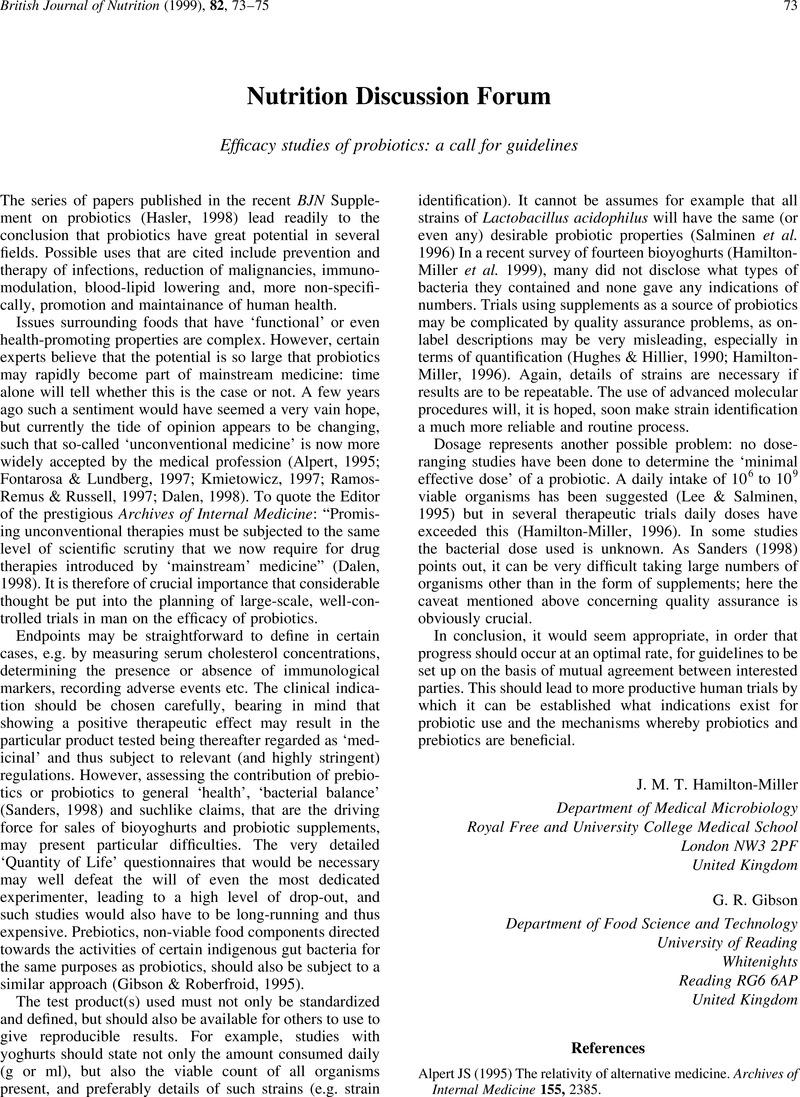Crossref Citations
This article has been cited by the following publications. This list is generated based on data provided by Crossref.
Sanders, M. E.
1999.
Efficacy studies of probiotics: a call for guidelines – reply by Sanders.
British Journal of Nutrition,
Vol. 82,
Issue. 1,
p.
74.
Shortt, C
1999.
The probiotic century: historical and current perspectives.
Trends in Food Science & Technology,
Vol. 10,
Issue. 12,
p.
411.
Hoa, Ngo Thi
Baccigalupi, Loredana
Huxham, Ashley
Smertenko, Andrei
Van, Pham Hung
Ammendola, Sergio
Ricca, Ezio
and
Cutting, Simon M.
2000.
Characterization of
Bacillus
Species Used for Oral Bacteriotherapy and Bacterioprophylaxis of Gastrointestinal Disorders
.
Applied and Environmental Microbiology,
Vol. 66,
Issue. 12,
p.
5241.
Shortt, Colette
Salminen, Seppo
and
Roberfroid, Marcel
2001.
Food and Nutritional Supplements.
p.
119.
Casula, Gabriella
and
Cutting, Simon M.
2002.
Bacillus
Probiotics: Spore Germination in the Gastrointestinal Tract
.
Applied and Environmental Microbiology,
Vol. 68,
Issue. 5,
p.
2344.
Hamilton-Miller, J.M.T
and
Shah, S
2002.
Deficiencies in microbiological quality and labelling of probiotic supplements.
International Journal of Food Microbiology,
Vol. 72,
Issue. 1-2,
p.
175.
Kwon, John H
and
Farrell, Richard J
2003.
Probiotics and Inflammatory Bowel Disease.
BioDrugs,
Vol. 17,
Issue. 3,
p.
179.
De Vuyst, L.
Avonts, L.
and
Makras, L.
2004.
Functional Foods, Ageing and Degenerative Disease.
p.
416.
Schröder, Sven
Schmidt, Ulja
Thiem, Joachim
Kowalczyk, Jörg
Kunz, Markwart
and
Vogel, Manfred
2004.
Synthesis of oligosaccharides as potential novel food components and upscaled enzymatic reaction employing the β-galactosidase from bovine testes.
Tetrahedron,
Vol. 60,
Issue. 11,
p.
2601.
Kliegman, Robert M.
and
Willoughby, Rodney E.
2005.
Prevention of Necrotizing Enterocolitis With Probiotics.
Pediatrics,
Vol. 115,
Issue. 1,
p.
171.
Hong, H.A.
Huang, J.-M.
Khaneja, R.
Hiep, L.V.
Urdaci, M.C.
and
Cutting, S.M.
2008.
The safety ofBacillus subtilisandBacillus indicusas food probiotics.
Journal of Applied Microbiology,
Vol. 105,
Issue. 2,
p.
510.
Nithya, Vadakedath
Muthukumar, Serva P.
and
Halami, Prakash M.
2012.
Safety Assessment of Bacillus licheniformis Me1 Isolated from Milk for Probiotic Application.
International Journal of Toxicology,
Vol. 31,
Issue. 3,
p.
228.
Mazzantini, Diletta
Calvigioni, Marco
Celandroni, Francesco
Lupetti, Antonella
and
Ghelardi, Emilia
2021.
Spotlight on the Compositional Quality of Probiotic Formulations Marketed Worldwide.
Frontiers in Microbiology,
Vol. 12,
Issue. ,
K., Bhanuramanand
P. V. S., Veena
B., Haritha Rani
Mehta, Dilip
Desouza, Anselm
and
Nalam, Madhusudhana Rao
2023.
Probiotics, Prebiotics, Synbiotics, and Postbiotics.
p.
535.



